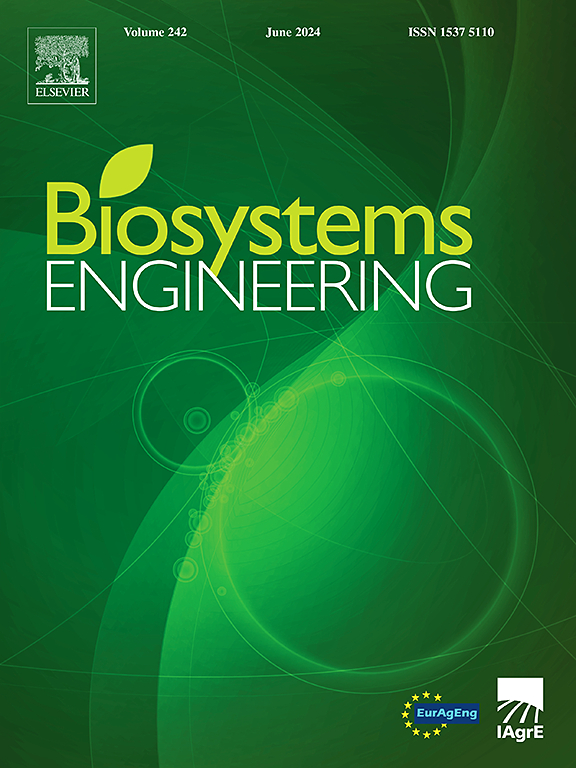CFD-DEM coupling simulation and parameter optimisation of sugarcane harvester extractor
IF 4.4
1区 农林科学
Q1 AGRICULTURAL ENGINEERING
引用次数: 0
Abstract
The impurity removal process of sugarcane mechanised harvesting by extractor faces the challenge of high impurity content and cane loss. To improve the impurity removal performance of extractor and explore the internal flow field and material movement, the impurity removal process was simulated using the computational fluid dynamics (CFD) and discrete element method (DEM) coupled method. The results revealed that the large-sized depression at the installation site of the hydraulic motor, along with variations in the blade profile at the leading and trailing edges, and the short length of the cleaning chamber, contributed to a wide range of vortex and flow separation, which made the material move in disorder and easily discharged from one side of outlet, reducing the impurity removal efficiency. With the number of blades, installation angle, and chord length as factors, and velocity and number of leaves as the indicators, a Box-Behnken experiment was conducted to optimise the extractor parameters. The results showed that, at speeds of 1250, 1450, and 1650 r min−1, the average outlet airflow velocity increased by 11.9%, 14.6%, and 19.9% respectively, the total pressure increased by 33.94%, 34.33%, and 25.19% respectively, and the extractor efficiency increased by 34.88%, 36.96% and 39.65% respectively. The improved extractor significantly reduced the impurity content while maintaining a stable cane loss at high travel speeds (3 km h−1), the corresponding reduction rates at the three speeds were 20.9%, 23.9%, and 18.0%. The research will contribute to guiding the design and optimisation of sugarcane harvester extractors.
甘蔗收获机抽采机CFD-DEM耦合仿真及参数优化
甘蔗机械化采收的抽提除杂工艺面临着杂质含量高、甘蔗损失大的挑战。为了提高抽提器的除杂性能,探索抽提器内部流场和物料运动,采用计算流体力学(CFD)和离散元法(DEM)耦合方法对除杂过程进行了模拟。结果表明:液压马达安装位置凹陷较大,前后缘叶型变化,清洗室长度较短,导致涡流和流动分离范围大,物料运动无序,容易从出口一侧排出,降低了除杂效率。以叶片数、安装角和弦长为影响因素,以叶片速度和叶片数为指标,进行Box-Behnken实验,对提取器参数进行优化。结果表明,在1250、1450和1650 r min−1转速下,平均出口风速分别提高了11.9%、14.6%和19.9%,总压分别提高了33.94%、34.33%和25.19%,萃取效率分别提高了34.88%、36.96%和39.65%。改进后的萃取器在高速(3 km h−1)下,杂质含量显著降低,同时保持了稳定的杂质损失率,3种速度下相应的还原率分别为20.9%、23.9%和18.0%。该研究将有助于指导甘蔗收获机抽提器的设计与优化。
本文章由计算机程序翻译,如有差异,请以英文原文为准。
求助全文
约1分钟内获得全文
求助全文
来源期刊

Biosystems Engineering
农林科学-农业工程
CiteScore
10.60
自引率
7.80%
发文量
239
审稿时长
53 days
期刊介绍:
Biosystems Engineering publishes research in engineering and the physical sciences that represent advances in understanding or modelling of the performance of biological systems for sustainable developments in land use and the environment, agriculture and amenity, bioproduction processes and the food chain. The subject matter of the journal reflects the wide range and interdisciplinary nature of research in engineering for biological systems.
 求助内容:
求助内容: 应助结果提醒方式:
应助结果提醒方式:


